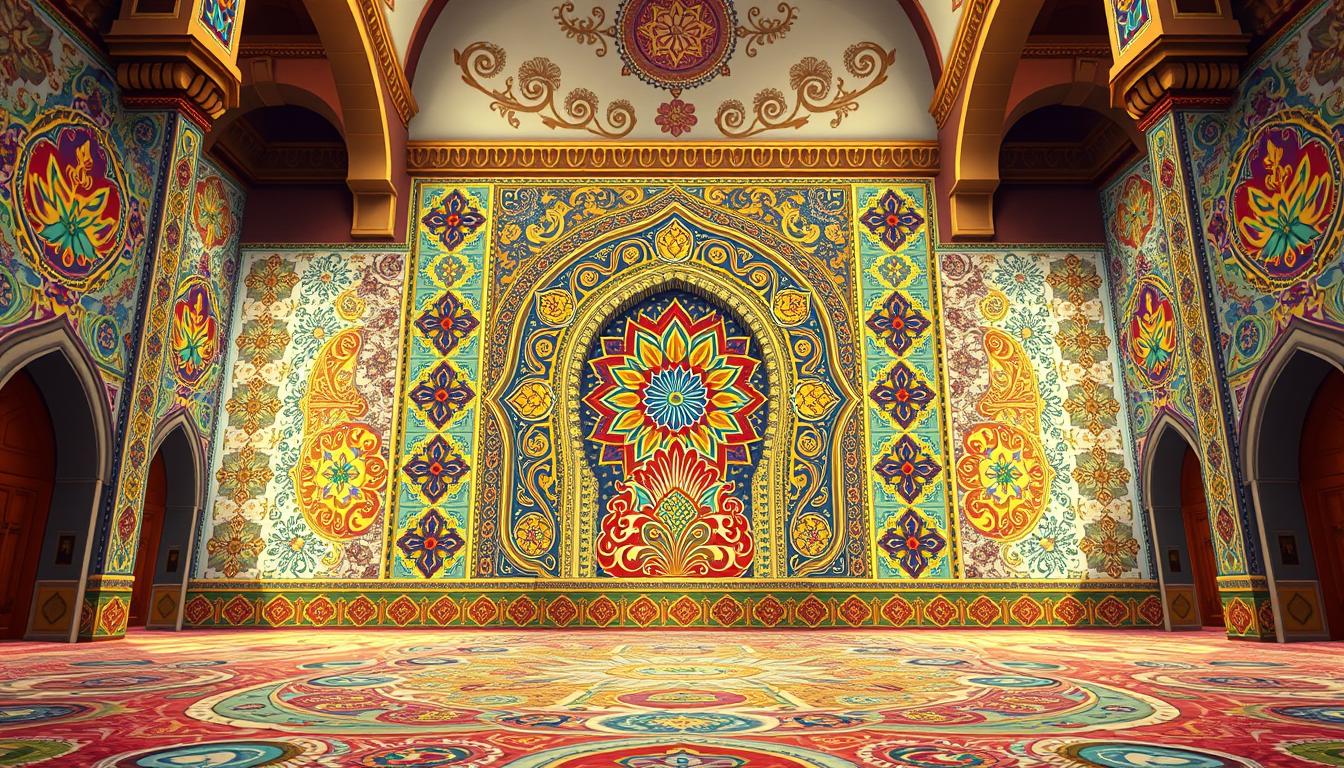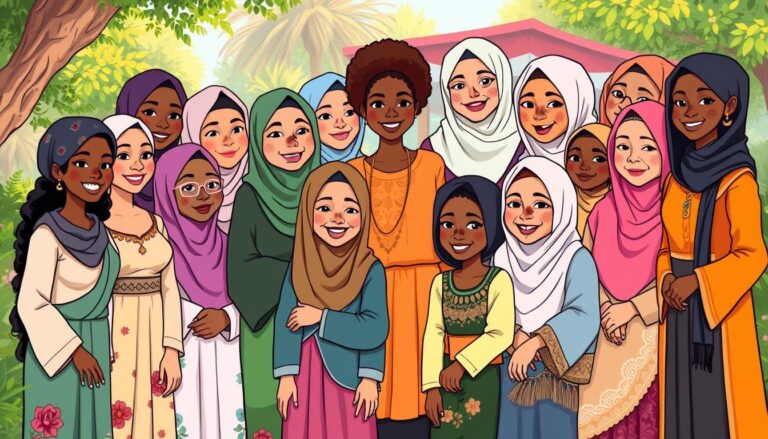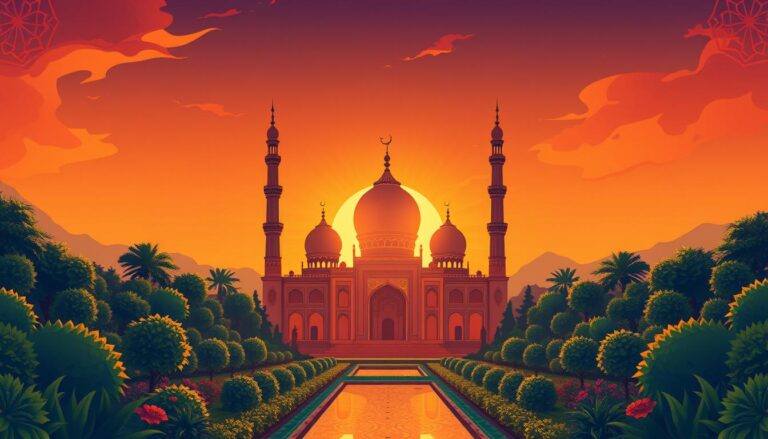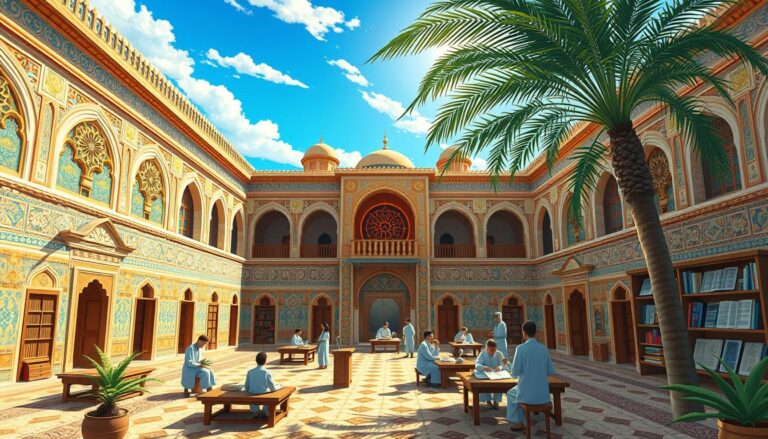The Beauty of Islamic Art: A Journey Through History
Have you ever wondered how Islamic art has lasted over 1400 years and still fascinates millions? Its detailed patterns and deep meanings take us on a captivating journey through time. This art form continues to inspire and amaze us all.
Islamic art’s history is as long as Islam itself. It has created a rich mix of creativity and spirituality. This art, deeply connected to Arab culture, shows a unique blend of different influences and faith.
As we explore Islamic art’s history, we see how it has changed over the centuries. We’ll look at famous sites like the Dome of the Rock in Jerusalem and the Taj Mahal in India. These buildings show the talent and vision of Muslim artists.
But Islamic art is more than just buildings. It also includes beautiful calligraphy, colorful textiles, and fine ceramics. Each piece shares a story, showing the beliefs, values, and tastes of Islamic cultures over time and place.
Key Takeaways
- Islamic art spans over 1400 years and three continents
- It includes architecture, calligraphy, painting, and textiles
- Geometric patterns and calligraphy are key elements
- Islamic art blends cultural influences with religious focus
- It has significantly influenced Western art and culture
Introduction to Islamic Art and Architecture
Islamic art and architecture started in the 7th century. It mixed many cultures. The Met has over 15,000 pieces from the 7th to 21st centuries. This shows how Islamic art has lasted for centuries.
Origins and Historical Context
The early days of Islamic architecture were marked by mosques and palaces. The Umayyad and Abbasid dynasties shaped the styles. The Abbasid Caliphate’s golden age saw calligraphy become a key art.
During this time, geometric patterns in mosques showed mathematical beauty.
Key Characteristics and Influences
Islamic art focuses on unity and divine order. It uses geometric patterns, arabesques, and calligraphy. Ottoman Empire mosques are famous for their design.
Persianate art’s influence is seen in the use of light in Islamic buildings.
Significance in Islamic Culture
Islamic art shows deep cultural and religious values. It avoided figurative art, leading to non-figurative forms. Calligraphers made Quranic verses into art.
Places like the Taj Mahal show the blend of Islamic and Indian styles.
“Islamic art celebrates unity through complexity, weaving together diverse influences into a tapestry of beauty and meaning.”
The Formation of Islamic Civilization and Its Impact on Art
The rise of Islamic civilization brought about a remarkable artistic development. This change shaped cultural heritage for centuries. The Umayyad caliphate (661-750) was key in laying the groundwork for Islamic art.
This era mixed different cultural styles, creating a unique artistic identity. This identity is still felt today.
Islamic art keeps its unique quality and identity, even with many regional influences. Its artistic expression includes calligraphy, vegetal patterns, geometric patterns, and figural representation. These elements are at the heart of Islamic ornament, showing the rich cultural heritage of the area.
The spread of Islam led to a boom in local art scenes in Spain, North Africa, and the Middle East. This growth allowed various styles and techniques to flourish. The art of miniature painting, for example, started after the 13th century, mainly in non-Arab countries.
“Islamic arts encompass literary, performing, and visual arts from the 7th century onwards, showcasing the depth and breadth of this civilization’s cultural impact.”
Calligraphy became a key part of Islamic art, partly because of the ban on representing living beings. This art form became a powerful way to express oneself, decorating architecture and everyday items. The focus on calligraphy highlights the value of the written word in Islamic culture and its artistic growth.
Distinctive Elements of Islamic Art
Islamic art is known for its unique visual language. It combines cultural influences from the vast Islamic world. This creates a rich tapestry of artistic expression.
Geometric Patterns and Abstraction
Islamic geometric patterns are a key feature of this art. These designs symbolize infinity and divine order. Artisans create complex symmetrical patterns that repeat endlessly, showing the boundless nature of Allah.
The use of geometry in Islamic art began in the 7th century CE. Over time, it evolved into more sophisticated forms.
Arabesque Motifs
Arabesque motifs are another important part of Islamic art. These designs mix geometric shapes with flowing, organic forms. They are inspired by nature, featuring stylized leaves, flowers, and vines.
The intricate interweaving of these elements creates harmony and balance. This reflects the unity of creation in Islamic belief.
Calligraphy as an Art Form
Islamic calligraphy is a unique art form. Calligraphers turn Quranic verses and poetic texts into visual masterpieces. The art of beautiful writing is very important in Islamic culture, as it preserves and celebrates the divine word.
Calligraphic styles vary across regions. From the flowing Naskh script to the angular Kufic script, each has its own beauty.
- Calligraphy adorns mosque walls, ceramics, and manuscripts
- Different scripts developed for various purposes and regions
- Calligraphers often combine text with geometric and floral motifs
These elements – geometric patterns, arabesque motifs, and calligraphy – create a visual language. It is both spiritually profound and aesthetically pleasing. They reflect Islamic culture’s core values and showcase the skill and creativity of Muslim artisans throughout history.
Islamic Architecture: A Blend of Form and Function
Islamic architecture started in the 7th century. It combines detailed designs with practical uses. This art spread from Spain to India, touching many cultures and landscapes.
Arches, domes, and minarets are key features. They look beautiful and serve important functions.
Mosques are central to Islamic architecture. The Great Mosque of Kairouan, built in 836 AD, is a prime example. Its large courtyard and tall minaret set a high standard for mosques.
The mosque’s design helps with prayer and thinking. It shows how architecture and spirituality can come together.
The Dome of the Rock in Jerusalem, finished in 691 AD, is another early achievement. Its golden dome and detailed patterns have inspired many. The building looks amazing and fulfills its religious role.
Islamic architecture is a testament to the harmony between beauty and functionality, reflecting the core values of Islamic civilization.
As Islamic architecture grew, it introduced new techniques and art. The Taj Mahal, built in the 17th century, shows this growth. Its white marble, with intricate carvings and precious stones, is stunning.
The Taj Mahal’s symmetry and size still amaze people today.
Today, Islamic design still shapes modern buildings. We see geometric patterns, calligraphy, and arabesques in new structures. These designs honor Islamic architecture’s rich history. They remind us of its lasting impact on design.
The Evolution of Islamic Artistic Traditions
Islamic art has evolved over 1400 years. It combines influences from many cultures and regions. This rich history is seen in the diverse art forms across the Islamic world.
Influence of Culture and Religion
Islamic art shows a deep spiritual connection. It often uses patterns and Arabic writing, avoiding pictures of people. This follows religious beliefs. The arabesque, a common design, represents God’s endless nature.
Development of Techniques and Materials
Artists have developed new techniques over time. They used materials like stone, wood, and ceramics. Lustre painting on pottery, starting in the Abbasid Caliphate, is a notable example.
Regional Variations in Islamic Art
As Islamic rule expanded, different areas developed their art styles. These regional variations came from local traditions and new cultural influences. For instance, Umayyad art mixed Coptic, Sassanian, and Byzantine styles. This mix of ideas made Islamic art exciting.
“Islamic art has evolved through peaceful exchanges of goods and ideas between different regions and civilizations.” – Ahmed Hassan, Islamic Art Expert
On October 23, 2024, Ahmed Hassan will host a free webinar on “The Beauty of Islamic Art: A Journey Through History”. Hassan, who studied at Al-Azhar University, will share insights on Islamic artistic traditions in both Arabic and English.
Iconic Islamic Landmarks Around the World
Islamic landmarks show the rich culture of the Muslim world. They span centuries and continents, showing Islamic art’s growth. Famous mosques and palaces inspire wonder and respect.
The Great Mosque of Samarra in Iraq was once the world’s largest. It covers 42 acres, showing early Islamic grandeur. In Spain, the Alhambra Palace is a top historical site, built in the 14th century.
Istanbul’s Suleymaniye Mosque complex, finished in 1557, shows Ottoman skill. It’s one of Istanbul’s biggest mosques. The Taj Mahal in India, built over 20 years, is a symbol of love and beauty.
Today, Islamic landmarks keep up the architectural excellence. The Hassan II Mosque in Morocco is among the world’s largest. Turkey’s Camlica Mosque, built recently, is the country’s biggest, with a museum and art gallery.
“Islamic architecture is a testament to the enduring power of faith and artistic expression.”
These landmarks are more than places of worship. They hold Islamic art and culture. They remind us of Islamic civilization’s impact on world heritage.
The Beauty of Islamic Art: A Journey Through History
Islamic art history spans over 1,400 years. It shows a rich mix of creativity and cultural exchange. From its start in 610 CE, Islamic art has grown into a unique form. It is known for four main themes: vegetative patterns, geometric designs, figurative art, and calligraphy.
Tracing Artistic Development from the 7th to 13th Century
In the early days, Islamic art was influenced by Roman, Christian, Byzantine, and Sassanian styles. As the Islamic empire grew, new art movements appeared. These blended local traditions with Islamic values.
This time saw big advances in architecture, manuscript illumination, and decorative arts.
Key Artistic Movements and Their Influence
Geometric patterns became a key part of Islamic art. They often used circles, squares, stars, and polygons. These designs showed the math and science skills of Islamic artists.
In the eighth century, there was a move away from figurative art in religious settings. This led to the rise of abstract forms and calligraphy.
The Golden Age of Islamic Art
The Golden Age of Islamic Art was a time of great creativity. Kufic script became a major calligraphic style, based on the Arabic script of the Quran. The Museum of Islamic Art in Qatar has amazing pieces from this time.
Today, Islamic art still inspires us. Events like Design Space AlUla and Desert X AlUla in Saudi Arabia celebrate this rich heritage. They connect the past and present through art.
Islamic Decorative Arts: Ceramics, Textiles, and Metalwork
Islamic decorative arts bloomed from the 8th to 11th centuries. They mixed many cultural styles. Each medium showed off unique skills and designs.
Ceramics in Islamic art are known for detailed designs and glazing skills. Artists made beautiful pieces with geometric patterns, flowers, and calligraphy. These items were both useful and decorative in Islamic homes.
Textiles were key in Islamic culture. They were for clothes, status signs, and art. Islamic fabrics were rich in color and pattern, often made of silk and cotton. Weavers used nature and shapes in their designs.
Metalwork showed the talent of Islamic craftsmen. They worked with gold, silver, bronze, and brass. Their creations, from everyday items to fancy decorations, were adorned with engravings or inlays.
“Islamic decorative arts serve as historical artifacts, offering insights into the social, cultural, and religious aspects of Islamic civilizations.”
The Khalili Collections of Islamic Art have over 28,000 items. They show the variety and growth of Islamic decorative arts. This huge collection includes ceramics, textiles, metalwork, and more, covering 1,400 years of Islamic art.
- Ceramics with intricate designs and glazing
- Textiles featuring rich colors and complex patterns
- Metalwork showcasing exceptional craftsmanship
Islamic decorative arts still amaze and attract people everywhere. They keep alive the rich cultural legacy of Islamic societies through their beauty and skill.
The Role of Symbolism in Islamic Art
Islamic art symbolism is key in showing religious and cultural ideas. It mixes spiritual thoughts with visual parts, making a special art language. Let’s dive into the symbolism in Islamic art and its importance.
Religious Symbolism
At the heart of Islamic art is religious symbolism. The number 99 is special, standing for Allah’s names. Geometric shapes, using prime numbers, show divine infinity. The number 5 is seen in buildings, showing the Five Pillars of Islam.
Cultural Symbolism
Cultural symbolism in Islamic art changes by region. Local customs mix with Islamic beliefs, leading to varied art. This mix created unique calligraphy styles like Kufic, Naskh, and Thuluth. Islam’s fast spread across the world also added to this cultural richness.
The Significance of Colors and Patterns
Colors and patterns in Islamic art have deep meanings. The number 8, in octagonal designs, means paradise. Intricate shapes show Allah’s endless nature. These elements make a visual language that touches both the eye and soul.
- Geometric patterns symbolize divine unity
- Calligraphy shows the value of the written word
- Prime numbers in designs represent divine symbolism
Islamic art symbolism keeps growing, with artists like Safia Latif rethinking old themes. This ongoing conversation between old and new keeps Islamic art alive and vibrant.
Preservation and Exhibition of Islamic Art in Modern Times
Keeping Islamic art safe is a big deal worldwide. Museums everywhere are showing off the rich history of Islamic cultures. The Los Angeles County Museum of Art has a huge collection from the 7th century to today.
This collection includes art from Spain to Central Asia. It gives visitors a full view of Islamic art traditions.
Modern shows are changing how we see Islamic art. With interactive screens and virtual reality, ancient pieces come alive. The Walters Art Museum in Baltimore has made its Islamic manuscripts digital.
This lets people all over the world see these treasures.
New museums for Islamic art show how much it’s valued now. The Museum of Islamic Art in Qatar and the Aga Khan Museum in Toronto are examples. They not only keep artifacts safe but also teach people about Islamic cultures.
“Islamic art is a window into the rich tapestry of human creativity and spiritual expression.”
But it’s not just about showing art. Experts use new ways to keep it safe. They work hard to protect things like textiles, manuscripts, and metalwork. This way, future generations can still be amazed by Islamic art’s beauty and detail.
The Influence of Islamic Art on Western Art and Culture
Islamic art has deeply influenced Western art, starting a cultural exchange that has lasted for centuries. The British Museum’s 2019 exhibition, ‘Inspired by the East: How the Islamic World Influenced Western Art,’ highlighted this impact. It showed pieces never seen before outside Malaysia, showing the strong ties between these artistic worlds.
Western artists were inspired by Islamic cultures, as seen in Frederick Arthur Bridgman’s ‘The Prayer’ (1877). This painting shows a barefoot old man praying, showing the West’s interest in Islamic religious practices. John Frederick Lewis, an English painter, lived in Cairo for ten years. He created works that captured the spirit of Islamic life.
The influence wasn’t just in painting but also in decorative arts. In the 17th and 19th centuries, Italian and Parisian artisans made ceramics that looked like Islamic pottery from the Ottoman period. The exhibition also showed works by women artists from the Muslim and Arab world. For example, İnci Eviner’s video installation ‘Harem’ (2009) challenges old views of women in Islamic art.
Looking at Islamic art and its impact on Western culture, we see a rich exchange that has shaped our global art heritage. From geometric patterns to calligraphy, Islamic art’s legacy inspires artists and audiences around the world. It helps us appreciate the diversity of artistic traditions.
Source Links
- Islamic Art and Architecture: A Journey Through History
- The Arts of Islam: Majesty and Beauty
- Unveiling the Beauty of Islamic Art: A Journey Through Time and Culture
- The Beauty of Islamic Art and Architecture – Muslim Blocks
- Islamic Art
- The Nature of Islamic Art | Essay | The Metropolitan Museum of Art | Heilbrunn Timeline of Art History
- Islamic arts | Characteristics, Calligraphy, Paintings, & Architecture | Britannica
- Art of the Islamic World: 7 Common Characteristics
- Islamic Art + History, Kinds, Characteristics & Pictures
- Recurring Themes in the Art of the Islamic World
- The Beauty of Islamic Art and Architecture – Muslim Blocks
- Exploring Islamic Architecture: A Cultural Journey
- Islamic Art and Architecture: Bridging Material and Spiritual Realms –
- A Journey Through Islamic Art and Culture Webinar
- Activities of "Exploring Islamic Art: A Journey Through Time and Culture"
- Islamic Art
- 8 Masterpieces of Islamic Architecture | Britannica
- 10 Islamic Landmarks To Visit in 2023 – British Muslim Magazine
- The Beauty of Islamic Art | Discover Qatar
- Islamic art: The art of Arabia
- Islamic arts – Calligraphy, Architecture, Ceramics | Britannica
- Islamic Art Collection | The Farjam Foundation
- The Khalili Collections | Islamic Art
- Islamic art and symbolism | Symbolism in Art Class Notes | Fiveable
- Islamic World Paintings: A Celebration of Islamic Art and Culture
- Islamic Art Collection at LACMA
- Museum of Islamic Art Presents Landmark Exhibition Surveying the Islamic Artistic Traditions of Morocco
- Reframing Islamic Art for the 21st Century
- The West Was Once in Love With the Islamic World
- How The Islamic World Influenced Western Art | Art & Object
- No title found







